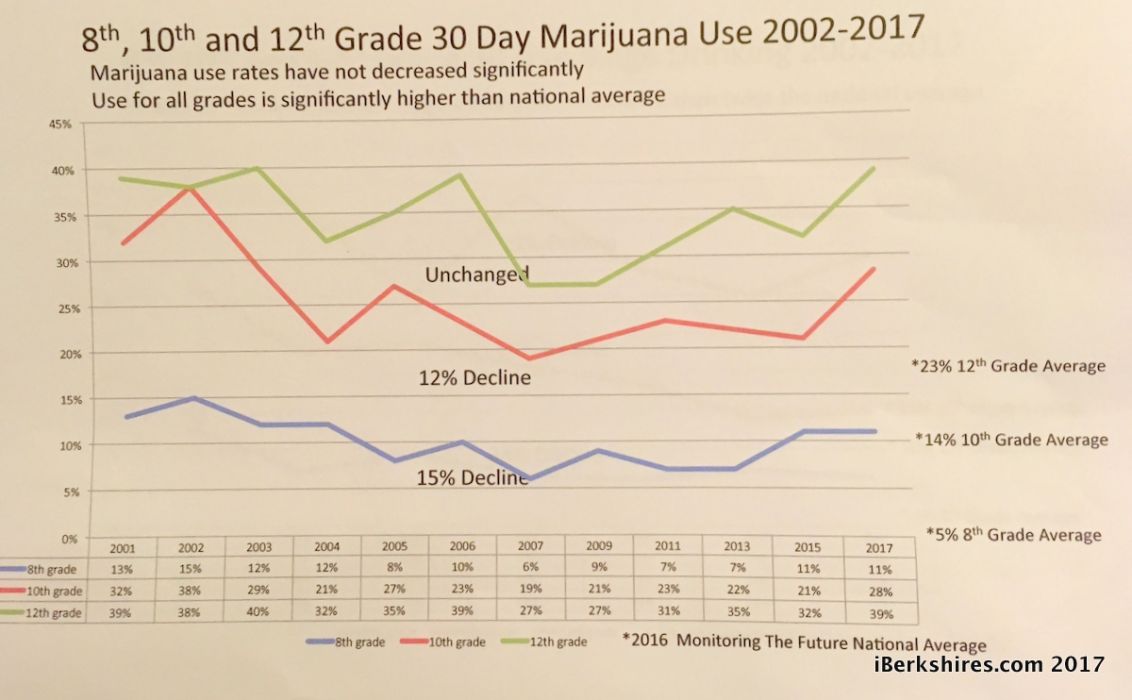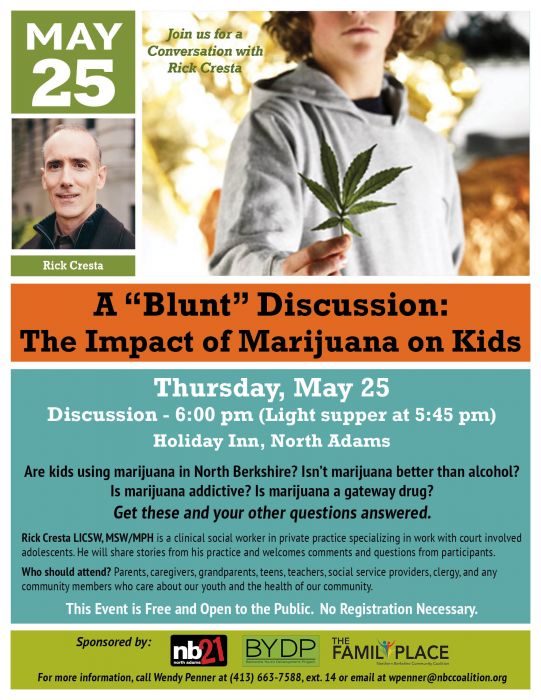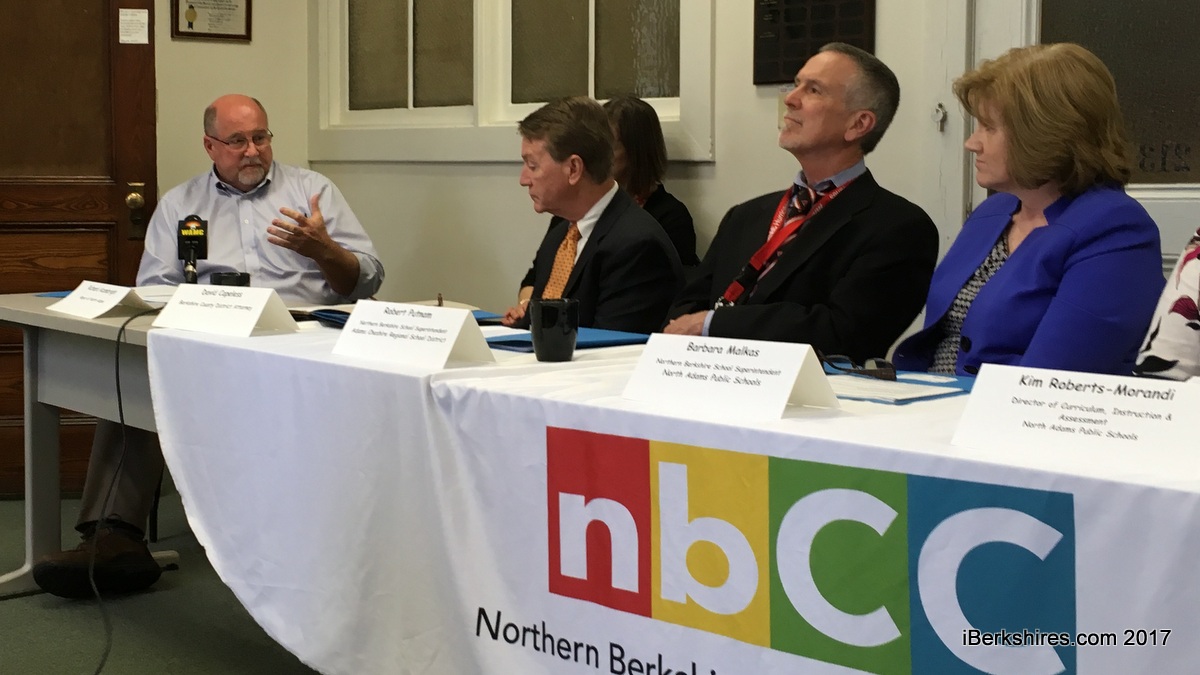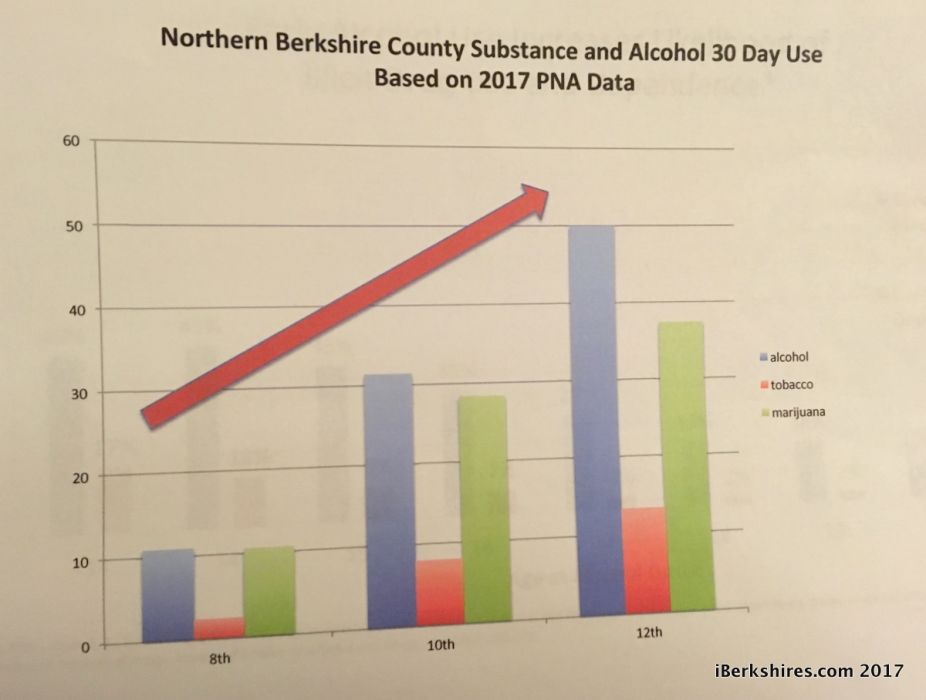
Youth Substance Use and Abuse Targeted in Prevention Efforts

NORTH ADAMS, Mass. — First, the good news.
Since the Northern Berkshire Community Coalition started keeping track of youth substance-abuse data in 2002, the percentage of Northern Berkshire students in eighth, 10th and 12th grades smoking cigarettes or using alcohol has dropped.
Now, the bad news.
Though those rates have dropped over the course of the last 15 years, they still top the national average. And a newer and more troubling statistic has emerged: the lack of any real decrease in the use of marijuana, which also remains well above the national average.
Those 2017 statistics — culled from needs assessment surveys completed by students, hospitals and pediatricians, parents, superintendents and other stakeholders — were presented Monday at the coalition offices in a news conference that brought many of those stakeholders together to interpret the numbers and discuss new strategies.
Wendy Penner, the coalition's director of prevention programs, presented the latest local data, which showed that the use of alcohol within the last 30 days has:
• Declined 35 percent since 2002 for 12th-graders to a current rate of 50 percent of students reporting use;
• Dropped 47 percent for 10th-graders to a current rate of 31 percent of students reporting use; and
• Plummeted 50 percent for eighth-graders to a current rate of 11 percent of students reporting use.
However, those numbers top the national average of 33 percent for 12th-graders, 20 percent for 10th-graders and 7 percent for eighth-graders. Also in terms of alcohol, the percentage of local students who reported "binge drinking" also came in well above the national average, particularly among 12th-graders, despite a trend downward in the younger two grades.
The decrease in use of tobacco was even more striking, though the use of e-cigarettes was captured for the first time in this survey at the same rate and polled at the same rate as traditional tobacco. But again, despite the decreases, the data showed that:
• 13.3 percent of 12th-graders in Northern Berkshire County report using cigarettes in the last 30 days, higher than the national 2.6 percent average;
• The same holds true for 10th-graders, though the gap narrows (8 percent locally versus 5 percent nationally); and
• By eighth grade only 2.4 percent of students report using cigarettes locally, compared to 2.4 nationally, a bright spot in the data.

But when it comes to marijuana, the good news is harder to spot. "The news is less encouraging," Penner said. "We've seen reversal in a downward trend."
Whether that is because of the legalization of recreational marijuana across the country, including Massachusetts, remains to be fully understood. But the data showed that:
• In 2001, 39 percent of 12th-graders reported using marijuana in the last 30 days, a number that dropped to under 30 percent in 2006 and 2007 only to spike back up to 39 percent in this last survey. The national average for 12th-graders is 23 percent.
• The same drop and spike is seen with 10th-graders, 28 percent of whom reported using marijuana locally this year, with the national average being 14 percent.
• The eighth-graders have also seen a spike, though a less dramatic one, leveling out now around 11 percent locally, well above the 5 percent seen nationally.
"By eighth grade, youths are already beginning to experiment with substances," Penner said.
And that's where the strategies of prevention come in: reaching those eighth-graders before they start using substances — well before, in fact, preferably as early as third grade. Raising awareness that early use of substances can damage the developing brain, and increase the risk for later addiction, is a crucial message for the community, members of the panel assembled on Monday all agreed.
One place that awareness can start with parents and their children is at annual well-child visits to pediatricians, who have committed to addressing prevention use with families starting at age 9. Dr. Jen DeGrenier from Northern Berkshire Pediatrics acknowledged that there can be resistance to starting the conversation so young.
"Initial response was a resistance, almost like it was inappropriate to have this conversation in front of their young child," DeGrenier said. "It's almost like talking about puberty with a 5-year-old."
However, the conversation is necessary to continue to educate and emphasize the danger of substance abuse on developing brains, and the statistics bear that out.
"We have a fair amount of active patients already who are engaged with these substances," she said. "We have been seeing this on the front lines."
A second place to offer education is through the schools, and that's where a program called Botvin LifeSkills comes into play. The program has shown significant reductions in later drug use nationally, and it was brought to the Berkshires by the district attorney's office. That office, in turn, brings it to the schools, offering resources and support. In Northern Berkshire County, a regional collaboration was formed this academic year and implemented by school staff to tailor it to each school's needs and schedules.
"It's been going well," said Justin Kratz, principal of McCann Technical School. "It's engaging stuff. It's really about getting kids comfortable with real-life situations."

Indeed, LifeSkills does not resemble the anti-drug programs of the past that many of the parents of today's students might remember.
"It's not the 'just say no' we were used to," said Kimberly Roberts-Morandi, director of curriculum, instruction and assessment for North Adams Public Schools. "We're not telling them what to do We're engaging them in a conversation … that will enable them to make wise choices."
Berkshire County District Attorney David Capeless praised the educators who have collaborated to offer the program using school staff, calling it a model for the rest of the county as more schools adopt the curriculum.
"It provides them with the personal skills — and self confidence and social skills with their peers — not only to make those choices, but to put them into action," Capeless said. "They learn to stand up for themselves, and maybe get one of their peers to go along with them, so they feel better about what they are doing."
Right now, he said, about 2,100 students around the Berkshires are participating in the program, but Capeless said his goal is to put it in every classroom in every district in Grades 3 through 8. (According to 2014 Census data, there are nearly 5,000 youths ages 10 to 19 in the 10 towns comprising Northern Berkshire alone.) There are obstacles to that, he said, like the time and resources not only in his office but in schools with "tight schedules," as well, and getting community buy-in. But he's optimistic.
"As more district embrace it, other districts see the enthusiasm and embrace it," he said.
The third place being targeted to educate families about youth substance use and abuse is perhaps the most meaningful one: the families themselves. Penner said a new media campaign will be coming soon to directly educate and engage parents to help their children make good choices. That means modeling good behavior themselves, Penner said, even down to thinking about the example parents set when having a glass of wine when they get home from work.
"Your example, your choices, have a powerful effect on your child," she said.
North Adams Mayor Richard Alcombright said he saw the idea of reinforcement at home as a particular challenge in North Berkshires.
"What the kids hear is one thing. What they see is another," he said, alluding to social situations that involve substances like alcohol that might not model appropriate behavior for children being difficult to change. "That takes time. These social norms have been carved into us for generations."
DeGrenier, the pediatrician, said she bumps up against that barrier with some of her families in trying to educate parents, who are not necessarily approving substance use but "excusing it" with an attitude of "it's not so bad." That's where the problem with legalizing recreational marijuana for adults comes into play, because laws don't necessarily talk about the effects of marijuana use on developing brains.

"That legalization has made it more benign in their minds," she said. "It's not benign."
(For those interested in the research on the effects of marijuana on kids, social worker Rick Cresta will be offering a free talk for parents, caregivers and concerned community members called "A ‘Blunt' Discussion: The Impact of Marijuana on Kids" on Thursday, May 25, at the Holiday Inn on Main Street in North Adams. A light supper will be served at 5:45 p.m. and the discussion will begin at 6 p.m.)
Amber Besaw, executive director of the coalition, said she was happy to see all the community partners who are invested in reducing substance abuse in Northern Berkshire youths.
"It really takes all of us," she said, even those people who think their child is somehow immune to the dangers of substance use and abuse that afflicts too many local youths. "It's not everybody. But it can be anybody."
Tags: NBCC, substance abuse,















